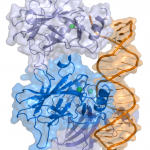p53 is a protein that plays a vital role in the G2 checkpoint phase before mitosis begins. This checkpoint “ serves to prevent the cell from entering mitosis (M-phase) with genomic DNA damage.” (http://www.cellsignal.com/reference/pathway/Cell_Cycle_G2M_DNA.html) The role of p53 is to trigger repair for damaged DNA if possible and to hold the cell in the G1/S checkpoint until it is repaired and if the repair of the DNA is not possible p53 triggers apoptosis. Therefore, p53 plays a large role is preventing cancer because a cancerous cell starts with a mutation in DNA. However mutant p53 allows cells who have DNA damage and have “tranformed” to be cancerous to enter into M-phase and proliferate thus forming a tumor.
Biologists, chemists and computer scientists at UC bolder however have discovered a “an elusive binging pocket” in the quaternary structure of p53 which is open “5 percent of the time.” (http://www.sciencedaily.com/releases/2013/01/130131121312.htm) The reason the pocket is only open 5 percent of the time is because the p53 protein undulates, meaning it sways so this pocket was hard to find and target. Their team then screened almost 2,500 molecules and tested out 45 molecules to see if any of them could fit into this pocket and trigger the normal tumor-suppressing abilities found in p53 in a mutated p53 molecule. They found that stictic acid fit and triggered the tumor-suppressing abilities. Although stictic acid is not able to be used as a drug, they can now scan other molecules that have similar properties as stictic acid making this a large step in cancer research because mutated p53 is found in over 40 percent of diagnosed cancer cases. (http://www.sciencedaily.com/releases/2013/01/130131121312.htm)
Sources:
http://www.sciencedaily.com/releases/2013/01/130131121312.htm
http://www.cellsignal.com/reference/pathway/Cell_Cycle_G2M_DNA.html



Leave a Reply